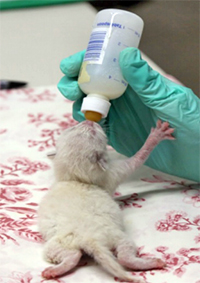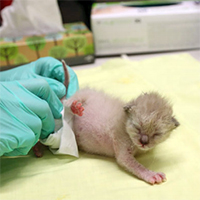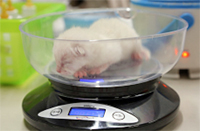If you found a litter of kittens and plan to care for them, please see our Orphaned Kitten Care Guidelines below or download the PDF here.
What to do if you find kittens?
START
Are the kittens visibly sick or injured?
IF YES: Take the kittens to a veterinary clinic immediately
IF NO:Estimate the kittens' age by what they look like:
Can you see the nest or hiding spot?
IF YES: Gently return the kittens to the nest where the mama cat can provide care.
What if the momma cat doesn't return after 6+ hours?
IF NO: If in danger, move the kittens to a safe place and watch from a distance.
What if the momma cat doesn't return after 6+ hours?
Are you willing to take full responsibility?
IF YES: GREAT!
Take the kittens to your local vet for a check-up right away & get them started on their vaccinations and parasite treatment as early as 4-6 weeks old. Raise them until the kittens are old enough for their Spay/Neuter surgery and adoption at about 8 weeks, or bring them to your local shelter to surrender them.
Further guidlines and supplies are available at San Diego Humane Society.
WANT TO FOSTER KITTENS IN NEED? » LEARN MORE
Bring the kittens to your local shelter.
Orphaned Kitten Care Guidelines
Since young kittens do not have the ability to regulate their body temperatures, we must help maintain body warmth for them.
If a kitten feels cold, it’s essential to begin the process of slowly warming them. Place the kitten on a heating pad or wrap them snugly in a warm towel until their temperature stabilizes.
Once warmed, the kittens should still be provided with a heat source, but should be given the ability to move off the source if they get too hot. Always make sure there is a blanket or towel between the kitten and the heat source to prevent them from being burned.
QUICK TIP: Sunbeam 731-500 heating pads set to medium are a good source of heat and do not automatically shut off.
Set up for a Warm Kitten
- For kittens less than 4-5 weeks, set up a cage or crate with a heating pad or disc on the bottom ensuring half the area has heat and the other half does not.
- Place a towel or blanket over the heat source. A soft fleece baby blanket works best.
- Cover the front of the crate with a towel to keep the area draft free.
QUICK TIP: A small dog/cat crate is a good size for kittens 0-2 weeks; a small guinea pig cage is the perfect size to house kittens 2-5 weeks. Older kittens will need more space to move around and can be kept in a small room.
Kitten Feeding
Any formula designed for kittens will be suitable for orphaned kittens. Cow’s milk is not nutritious enough for kittens and causes diarrhea. Once prepared the kitten formula must be refrigerated if not used right away. It must be discarded after 24 hours or else it will spoil and cause kittens to get diarrhea.
Quick Tip: San Diego Humane Society recommends using Revival's Breeders' Edge kitten formula.
- Formula is made with 1 part formula to 2 parts warm water.
- Kittens less than 2 weeks of age should eat every 3-4 hours.
- Kittens 2-4 weeks should eat every 4-5 hours.
- Kittens should eat approximately 30 mls of formula for every 100g they weigh. This should be spread over a 24 hour period.
- Kittens that are weak and not eating enough may need to be fed more frequently. These kittens may also need supportive fluids and dextrose.
- There will be individual variations in the frequency and amounts for each kitten.
| Age (weeks) | Expected Weight (grams) | ml (cc) per day | Number of Daily Feedings |
|---|---|---|---|
| 1 | 100-148 | 32 | 6-8 |
| 2 | 156-212 | 56 | 4-6 |
| 3 | 228-330 | 80 | 3-4 |
| 4 | 344-430 | 104 | 3 |
| 5 | 446-560 | 128 | 3 |
| 6+ | 556-650 | Variable due to weaning | 3 |
General Feeding Instructions
 Test the formula temperature before feeding; it should be warm, not hot, and around 100°F. You should warm the bottle by placing it in hot water or a microwave can be used. If you use a microwave, be aware that the milk may not heat up evenly. Mix the formula well and test the temperature before feeding.
Test the formula temperature before feeding; it should be warm, not hot, and around 100°F. You should warm the bottle by placing it in hot water or a microwave can be used. If you use a microwave, be aware that the milk may not heat up evenly. Mix the formula well and test the temperature before feeding.
Positioning is very important. Laying kittens on their backs while feeding may cause aspiration which is when kittens inhale formula into their respiratory tract rather than swallowing. Aspiration can lead to pneumonia which is often fatal in young kittens. To prevent aspiration, feed the kitten flat on their belly.
This is the position they are in when nursing from their mom. The kitten can be slightly propped up on a towel or blanket to assist with the feeding position. If the kitten acts frantic at feeding time, gently hold the kitten by the cheeks and guide the bottle into the mouth. You may need to hold their front paws down to prevent them from climbing up your hand.
When placing the bottle into the kitten’s mouth, open the mouth gently with the tip of your finger. You may need to place the nipple in from the side of the mouth rather than into the front. Once in the mouth, you can reposition the nipple to the front. Once kittens are used to the artificial nipple they will seek it out and latch easily. During a latch, you will feel a strong vacuum as they suckle. Watch for bubbles in the bottle and wiggling ears to indicate a good latch. To prevent air from getting into the stomach, hold the bottle at a 45 degree angle. Slightly pulling back on the bottle can often get the kitten to have a stronger latch. Kittens will drink at their own pace and the bottle should never be squeezed. Squeezing milk into the kitten’s mouth can cause aspiration.
If they refuse to take to the nipple or suckle, try rubbing the kittens cheeks or cupping their faces. This often encourages them to latch. If you have multiple kittens you can feed them together to encourage sibling competition for the nipple.
Quick Tip: Using a tooth brush to “groom” the kitten helps them to relax because the roughness feels like a mama cat’s tongue.
Feeding Multiple Kittens
Feed each kitten multiple times, taking turns. Feed the first kitten until she stops nursing; note how much she ate then go on to feed the second. Once you have fed all kittens in the group, go back and repeat the process. Kittens will usually nurse 3-4 times during 1 feeding session. If you have a group of kittens larger than four, it may be challenging to keep track of them all as individuals. It may be easier to split the kittens up into smaller groups. When a kitten has had enough formula, she will usually un-latch from the bottle, stop vocalizing and appear sleepy.
Kittens that are too weak to nurse may be too cold or have an underlying medial issue. If a kitten does not eat in two feeding cycles, they can become dehydrated and lethargic quickly. It is important to contact a veterinarian if this occurs.
Sucking behavior is normal for kittens before, during and after feedings. Sometimes you will see kittens nursing on each other. If this behavior occurs frequently, you may need to decrease the time between feedings. If littermates sucking on each other becomes problematic, you may need to separate the kittens in to different housing areas. It is a good idea to check each kitten’s genital area to make sure sucking is not causing issues (redness, swelling, irritation). Sucking on genitals can cause blockages of the urethra. This can be fatal, so if you notice a kitten has swollen genitals and can’t urinate, you should contact a veterinarian immediately.
Stimulation for Urine and Feces
 Mom cats groom their kittens to stimulate for urine and feces throughout the day and night. If you are caring for orphaned kittens you will mimic this task using toilet paper
Mom cats groom their kittens to stimulate for urine and feces throughout the day and night. If you are caring for orphaned kittens you will mimic this task using toilet paper
Before and after each feeding, gently rub the kitten around the genitals and rectum. You can dip the toilet paper in warm water or use a fragrance free baby wipe. Be careful not to be too rough or you may cause irritation of the sensitive area. Kittens should urinate at every feeding. They usually defecate at least once a day. If kittens have diarrhea, they may defecate at every feeding and between feedings causing them to need bathing. Kittens usually need stimulation until they are around 3 weeks of age. At this time they will start to use the litter box. The litter box can be introduced at 2½ - 3 weeks. Do not use clumping litter as this can cause issues if ingested.
It is a good idea to introduce dry food at the same time you introduce litter. This will encourage the kittens to chew on the dry food rather than the litter. If you notice kittens eating litter, you may need to replace it with shredded paper until they are further through the weaning process. Kittens will have accidents outside of the litter box when they are learning. You can use a potty pad to prevent messes.
Quick Tip: Kittens usually start learning to use the litter box at 3 or 4 weeks of age but will need some help. A disposable cookie sheet or the lid to a cardboard shoe box works until they are bigger and can be transitioned to a “big kitty” box. If a kitten is defecating outside of the box move the feces into the box. Smelling the feces in the box will encourage them to go into the box next time to go potty.
Weaning
 A kitten is ready to be introduced to wet food at 3 ½ weeks of age. You may see them biting the nipple of the bottle or becoming more frantic at feeding times. It is necessary to continue bottle feeding through the weaning process to ensure the kittens get adequate nutrition and are not stressed.
A kitten is ready to be introduced to wet food at 3 ½ weeks of age. You may see them biting the nipple of the bottle or becoming more frantic at feeding times. It is necessary to continue bottle feeding through the weaning process to ensure the kittens get adequate nutrition and are not stressed.
Introduce kittens to wet food by offering a starter bite in their mouth. At first they may spit it out, but if you do this before every bottle feeding, eventually the kittens will start to eat the wet food. You may need to spike the wet food with formula, since this is a smell and taste they are already familiar with.
Most kittens going through the weaning process are messy eaters, they may dive head first into their dish with their face and paws. Very messy eaters may need to be wiped down or bathed before being placed back into their housing area. Crusted on wet food and formula can cause hair loss or sores on the kitten’s face and paws, but by keeping them clean from the debris you will prevent any issues from occurring.
Bathing
 Kittens may get dirty at feeding time or between feedings. If the kitten has urine or feces around his rear, a “butt bath” rather than full bath can be given to remove debris. This is important because any urine or feces left on the fur and skin can cause scalding and painful sores.
Kittens may get dirty at feeding time or between feedings. If the kitten has urine or feces around his rear, a “butt bath” rather than full bath can be given to remove debris. This is important because any urine or feces left on the fur and skin can cause scalding and painful sores.
Steps to bathing:
- You can wash the kitten under running water or use a small basin.
- Ensure water temperature is warm, not hot. It should feel like the water temperature if you were taking a bath.
- Have a towel on standby.
- Gently wet the kitten. It is important not to submerge the head or get water in the ears.
- Apply a small amount of Dawn or Baby Shampoo and lather.
- Rinse the kitten and immediately wrap in towel.
- Blow dry the kitten on low until he is completely dry.
Quick Tip: Kittens often want to nurse or eat again after bath time, so attempt to feed one more time before placing back in housing area.
Weight Gain
 Kittens should gain 10-15grams daily or approximately 100g per week. Weighing them at the same time every day will help minimize seeing fluctuations in weight. Lack of weight gain over 2-3 days is concerning and should be flagged to your veterinarian or contact person at San Diego Humane Society.
Kittens should gain 10-15grams daily or approximately 100g per week. Weighing them at the same time every day will help minimize seeing fluctuations in weight. Lack of weight gain over 2-3 days is concerning and should be flagged to your veterinarian or contact person at San Diego Humane Society.
Quick Tip: Weighmax Electronic Kitchen Scales come with a bowl and are perfect for weighing all ages of kittens. They retail for less than $12.
Common Kitten Medical Warning Signs
If your kitten shows any symptoms below, notify your veterinarian or contact at San Diego Humane Society. Young kittens are very fragile and it is important that they receive an exam and treatment in a timely manner.
RED FLAGS:
- Kitten did not eat during last two feeding attempts
- Kitten had weight loss for 2-3 days in a row
- Kitten has liquid diarrhea
- Kitten appears dehydrated
- Kitten is listless
- Kitten has vomited multiple times
- Kitten is having trouble urinating
- Kitten is bleeding
- Kitten has neurologic signs
YELLOW FLAGS:
- Kitten is sneezing, wheezing, has nasal discharge or is coughing
- Kitten has ocular discharge with a yellow or green coloration
- Kitten has mild lethargy or seems depressed
- Kittens weight is static
- Kitten has loose stool
- Kitten has occasional vomiting
- Kitten has poor appetite compared to usual
- Kitten is having difficulty defecating
- Kitten is limping
- Kitten is showing unusual behavior for age
For additional resources, visit the Kitten Lady website.



